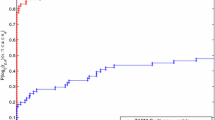Abstract
This paper gives a brief list of commonly used direct and indirect efficient methods for the numerical solution of optimal control problems. To improve the low accuracy of the direct methods and to increase the convergence areas of the indirect methods we suggest a hybrid approach. For this a special direct collocation method is presented. In a hybrid approach this direct method can be used in combination with multiple shooting. Numerical examples illustrate the direct method and the hybrid approach.
Similar content being viewed by others
References
A.E. Bryson and Y.-C. Ho,Applied Optimal Control, Rev. Printing (Hemisphere, New York, 1975).
R. Bulirsch, Die Mehrzielmethode zur numerischen Lösung von nichtlinearen Randwertproblemen und Aufgaben der optimalen Steuerung, DLR, Oberpfaffenhofen, Germany, Report of the Carl-Cranz-Gesellschaft (1971). Reprint: Department of Mathematics, Munich University of Technology (1985).
R. Bulirsch, F. Montrone and H.J. Pesch, Abort landing in the presence of a windshear as a minimax optimal control problem. Part 1: Necessary conditions. Part 2: Multiple shooting and homotopy, Schwerpunktprogramm der DFG: Anwendungsbezogene Optimierung und Steuerung, Report No. 210 (1990), J. Optim. Theory Appl. (1991), to appear.
R. Bulirsch, E. Nerz, H.J. Pesch and O. von Stryk, Maximum range trajectory of a hangglider through a thermal, in preparation.
H.G. Bock and K.J. Plitt, A multiple shooting algorithm for direct solution of optimal control problems,IFAC 9th World Congress, Budapest, Hungary (1984).
R. Callies and R. Bulirsch, Optimale Flugbahn einer Raumsonde zum Planetoiden Vesta, Jahrbuch der DGLR II(1990)895–904.
K. Chudej, R. Bulirsch and K.D. Reinsch, Optimal ascent and staging of a two-stage space vehicle system, Jahrbuch der DGLR I(1990)243–249.
F.L. Chernousko and A.A. Lyubushin, Method of successive approximations for optimal control problems (survey paper), Opt. Contr. Appl. Meth. 3(1982)101–114.
E.D. Dickmanns and K.H. Well,Approximate Solution of Optimal Control Problems Using Third Order Hermite Polynomial Functions, Lecture Notes in Computational Science, Vol. 27 (Springer, Heidelberg, 1975) pp. 158–166.
G. Feichtinger and A. Mehlmann, Planning the unusual: Applications of control theory to nonstandard problems, Acta Appl. Math. 7(1986)79–102.
P.E. Gill, W. Murray, M.A. Saunders and M.H. Wright, User's Guide for NPSOL (version 4.0), Report SOL 86-2, Department of Operations Research, Stanford University, California (1986).
R.G. Gottlieb, Rapid convergence to optimum solutions using a min-H strategy, AIAA J. 5(1967)322–329.
C.R. Hargraves and S.W. Paris, Direct trajectory optimization using nonlinear programming and collocation, AIAA J. Guidance 10(1987)338–342.
M.R. Hestenes,Calculus of Variations and Optimal Control Theory (Wiley, 1966).
M.K. Horn, Solution of the optimal control problem using the software package STOMP,8th IFAC Workshop on Control Applications of Nonlinear Programming and Optimization, Paris (1989).
J. Konzelmann, H.G. Bock and R.W. Longman, Time optimal trajectories of elbow robots by direct methods,Proc. AIAA Guidance, Navigation, and Control Conf., Boston (1989) AIAA Paper 89-3530-CP.
D. Kraft, On converting optimal control problems into nonlinear programming codes, in: NATO ASI Series, Vol. F15,Computational Mathematical Programming, ed. K. Schittkowski (Springer, 1985) pp. 261–280.
A. Miele, Gradient algorithms for the optimization of dynamic systems, in:Control and Dynamic Systems, ed. C.T. Leondes, Vol. 16 (Academic Press, 1980) pp. 1–52.
H.J. Oberle, Numerische Berechnung optimaler Steuerungen von Heizung und Kühlung für ein realistisches Sonnenhausmodell, Habilitationsschrift, Munich University of Technology, Germany (1982), Report No. M8310 (1983).
H.J. Oberle and W. Grimm, BNDSCO — a program for the numerical solution of optimal control problems, Deutsche Forschungs- und Versucbsanstalt für Luft- und Raumfahrt (DLR), Oberpfaffenhofen, Germany, DLR IB 515-89/22 (1990).
H.J. Pesch, Real-time computation of feedback controls for constrained optimal control, Part 2: A correction method based on multiple shooting, Optim. Contr. Appl. Meth. 2(1989)147–171; see also: Schwerpunktprogramm der DFG: Anwendungsbezogene Optimierung und Steuerung, Reports no. 8 and 14 (1987).
J.J. Renes, On the use of splines and collocation in a trajectory optimization algorithm based on mathematical programming, National Aerospace Lab. Amsterdam, The Netherlands, NLR-TR78016 U (Sept. 1978).
J. Stoer and R. Bulirsch,Introduction to Numerical Analysis, 2nd rev. ed. (Springer, 1983).
O. von Stryk, Ein direktes Verfahren zur näherungsweisen Bahnoptimierung von Luft- und Raumfahrzeugen unter Berücksichtigung von Beschränkungen,
Diploma Thesis, Department of Mathematics, Munich University of Technology, Germany (May 1989);
Lecture at the Institute for Flight Systems Dynamics, DLR, Oberpfaffenhofen, Germany (June 16th 1989);
O. von Stryk,Annual Scientific Conf. of the GAMM, Hannover, Germany (1990), Zamm 71, 6(1991)T705-T706.
H. Tolle,Optimierungsverfahren (Springer, Berlin, 1971).
J. Vlassenbroek and R. van Dooren, A Chebyshev technique for solving nonlinear optimal control problems, IEEE Trans. Aut. Contr. AC-33(1988)333–340.
W.E. Williamson, Use of polynomial approximations to calculate suboptimal controls, AIAA J. 9(1971)2271–2273.
Author information
Authors and Affiliations
Rights and permissions
About this article
Cite this article
von Stryk, O., Bulirsch, R. Direct and indirect methods for trajectory optimization. Ann Oper Res 37, 357–373 (1992). https://doi.org/10.1007/BF02071065
Issue Date:
DOI: https://doi.org/10.1007/BF02071065




